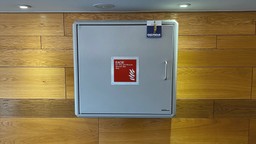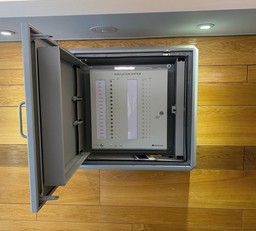EACIE: Emergency Evacuation Systems for High-Rise Buildings
High-rise buildings present unique fire safety challenges due to their height, number of residents, and complex layouts. A reliable emergency evacuation system for high-rise buildings is vital to safeguard lives and ensure systematic evacuations. At Gerda Security, we are committed to providing advanced systems that prioritise safety, efficiency, and compliance with standards like BS 8629:2019.… Continue reading EACIE: Emergency Evacuation Systems for High-Rise Buildings
High-rise buildings present unique fire safety challenges due to their height, number of residents, and complex layouts. A reliable emergency evacuation system for high-rise buildings is vital to safeguard lives and ensure systematic evacuations. At Gerda Security, we are committed to providing advanced systems that prioritise safety, efficiency, and compliance with standards like BS 8629:2019.
Below, we detail how these systems work, their essential components, and why they are critical for fire safety in modern infrastructure.
Key Takeaways
- Purpose: Designed to assist fire and rescue services in managing safe evacuations.
- Compliance: Meets legal requirements for high-rise buildings under BS 8629:2019.
- Core Features: Includes alert panels, sounders, visual indicators, and more.
- Benefits: Enhances safety, ensures clear communication, and simplifies evacuations.
Why Emergency Evacuation Systems Are Crucial
High-rise buildings house many people, making timely evacuations critical during emergencies. Traditional fire alarms are essential, but often insufficient to manage evacuations in these structures. Systems like the EACIE™ (Evacuation Alert Control and Indicating Equipment) address this by providing targeted evacuation capabilities that prioritise specific zones or floors based on risk.
How Emergency Evacuation Systems Work
Unlike standard fire alarm systems, evacuation alert systems operate independently, ensuring they remain functional even if the primary alarm system is compromised.
Manual Control by Fire and Rescue Services
The system is controlled manually by the Fire and Rescue Service (FRS) using secure panels. These panels feature intuitive toggle switches that allow responders to:
- Activate evacuation alerts for specific floors or zones.
- Minimise panic by controlling the evacuation process step-by-step.
All Gerda Emergency Access Systems, like the EACIE™, are equipped with the GSP One Key Locking System, adding an extra layer of security whilst being easily accessible by your FRS.
Key Components of an Evacuation System
A robust emergency evacuation system for high-rise buildings comprises several critical elements:
- Evacuation Alert Panels: These serve as the command centre, giving responders complete control.
- Sounders: Emitting powerful 110dB alerts, audible even in noisy environments.
- Visual Indicators: Aiding compliance with the Equality Act by supporting residents with hearing impairments.
- Vibrating Pillow Pads: Ensuring individuals who are hard of hearing or asleep are notified.
Each component plays a role in delivering a clear, effective response during an emergency.
EACIE™ Enclosures: Durable and Secure
The EACIE™ Enclosure is a secure housing unit for evacuation control panels, specifically designed for FRS use.
Features of the EACIE™
- Built from steel and tested to STS205 BR2 standards for durability.
- Resistant to weathering and corrosion, ensuring long-term reliability.
- Features specialist signage for easy identification during emergencies.
By securing critical controls, the EACIE™ enhances the system’s resilience and functionality.
Targeted Evacuations for High-Rise Safety
One of the most significant advantages of these systems is their ability to facilitate targeted evacuations. This approach to emergency evacuation from high-rise buildings focuses on evacuating high-risk areas first, preventing overcrowding in key areas such as stairwells, and reducing panic.
Targeted evacuation not only prioritises safety but also allows responders to manage resources efficiently during emergencies.
For more on high rise safety, explore our guide to fire safety in flats.
Compliance with BS 8629:2019
To meet regulatory standards, all systems must comply with BS 8629:2019, which covers the design, installation, and maintenance of evacuation alert systems for buildings over 18 metres in height.
Key Compliance Areas
- Design: These systems must be intuitive to use, and robust.
- Installation: Proper integration into the building’s structure is required.
- Maintenance: Regular inspections and testing are also essential to ensure ongoing reliability.
Compliance protects building owners from liability while significantly enhancing resident safety.
Maintenance and Upgrades
Regular maintenance ensures the long-term reliability of evacuation systems, the following practices are recommended:
- Annual inspections: Ensure all components remain in optimal condition.
- Upgrades: Retrofit existing buildings with the latest technology for improved compliance and safety.
Benefits of Emergency Evacuation Systems
Installing an emergency evacuation system for high-rise buildings provides numerous benefits, including:
- Enhanced Safety: The capacity for systematic evacuations minimises risk.
- Improved Communication: Residents receive clear, timely alerts and instructions in an emergency.
- Flexibility: Systems can be retrofitted into older buildings or integrated into new constructions.
For more on the advantages of upgrading your building’s safety features, learn more about the EACIE™ by Gerda Security.
Frequently Asked Questions
What is an emergency evacuation system for high-rise buildings?
It’s a system that helps fire and rescue services safely evacuate residents during emergencies.
How does the EACIE™ improve evacuation processes?
The EACIE™ allows responders to activate alerts for specific floors or zones, ensuring targeted emergency evacuation from high-rise buildings.
Are these systems required in all high-rise buildings?
Yes, for buildings over 18 metres in height, compliance with BS 8629:2019 is mandatory.
Can older buildings be fitted with these systems?
Yes, evacuation systems can be retrofitted into existing structures.
How often should these systems be tested?
Monthly self-tests and annual inspections are recommended to ensure functionality.



